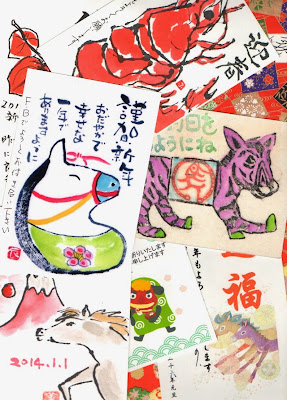Wednesday, January 1, 2014
new year's day in japan
Japan has a long tradition of exchanging New Year's greetings in writing, going as far back as the Nara period (AD 700s). But it wasn't until 1873, when the Japan Postal Service began to print standardized postcards requiring less postage than an ordinary letter, that the idea of postcard greetings, called nengajou, began to catch on. In 1899, the current system of nenga yuubin (New Year mail) was conceived, in which all mail which is marked nenga (New Year's greeting) and posted within a specific time frame in December, gets delivered en mass on New Year's Day.
There are many cool things about nengajou postcards, not the least of which is how images and words are used.
Certain auspicious images are associated with the New Year holiday specifically, or with spring in general-- since New Year's Day is the symbolic beginning of spring. Images commonly used on nengajou include red-crowned cranes, Mt. Fuji, plum blossoms, and the zodiac animal that goes with that particular year. Toys like fighting spinning tops, colorful playing cards, kites, and brightly painted hanetsuki paddles may be depicted on these cards because they are among the toys that children traditionally played with during the New Year holidays. Click on the links to find out more about these toys.
Word-play abounds in nengajou. A card with the image of a spinning top might say: May 20xx be a well-balanced year for you. A card depicting a kite might say: May you reach new heights this year.
Not all New Year's cards are etegami, of course. These days most people whip up greeting cards on their computers and printers, using stock images and formulaic words. Hand-made nengajou are all the more valued because of this.
2014 is the year of the horse. The pictures posted here are just some of the many, many nengajou that were delivered to my door early this morning. A few came from people that weren't already on my list, so I will spend the next few days painting more nengajou to send in reply to those cards. They will get delivered several days late, of course, but it is not uncommon for people to have no time to make and send nengajou until the holidays have actually started. In fact, I expect to receive the bulk of my nengajou in small batches during the next several days, until the total is two or three times the number I received today. It's the thought that counts, of course, and nengajou are a really fun way to convey those thoughts.
Subscribe to:
Post Comments (Atom)
































Such a beautiful tradition Debbie. They are lovely. What a joy to receive. Happy New Year my friend in Japan!
ReplyDelete謹賀新年, Debbie。お体に気をつけて.今年があなたにとって一層の飛躍の年となるよう心からお祈り申し上げます.
ReplyDeleteHappy New Year. Take care. May this year will be your wonderful year, I pray with all my heart. Go, Debbie!
Best wishes, Sadami
Have a wonderful time with your Art!
ReplyDeleteI wish you all the possible little joys to accumulate day after day to end up with a wonderful year 2014!
This was fascinating, thank you for posting it! One card that really stood out for me was that bright red lobster!!
ReplyDeleteWow!!
Happy New Year Blessings,
Mary
Dear, dear Google...
ReplyDeleteI lost my entire reply to you...
OK, starting again... Your post was fascinating, thanks for all thr background info!!
That bright red lobster is gorgeous amongst many lovely and funny cards.
Happy New Year, Debbie!
ReplyDeletewhat a lovely tradition
ReplyDelete